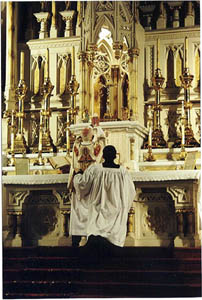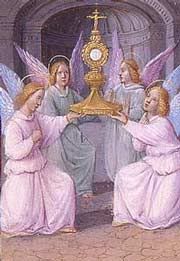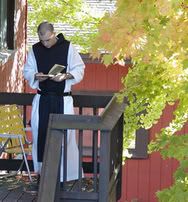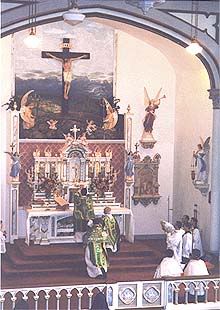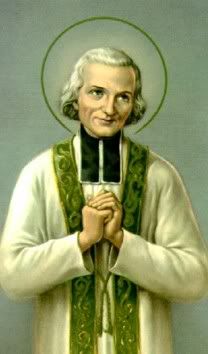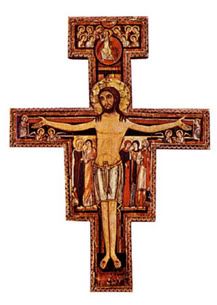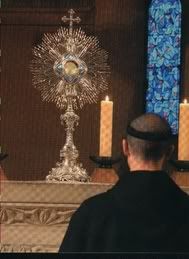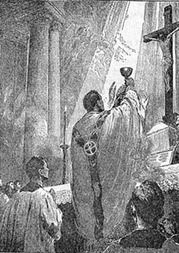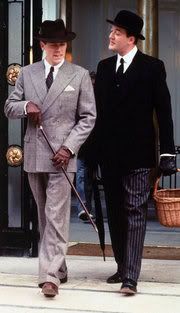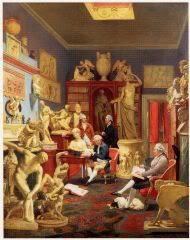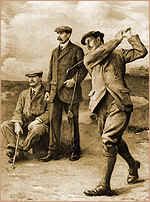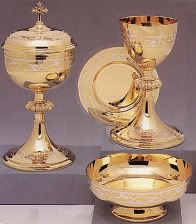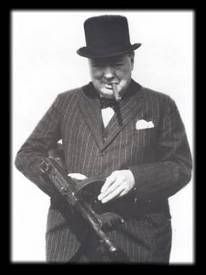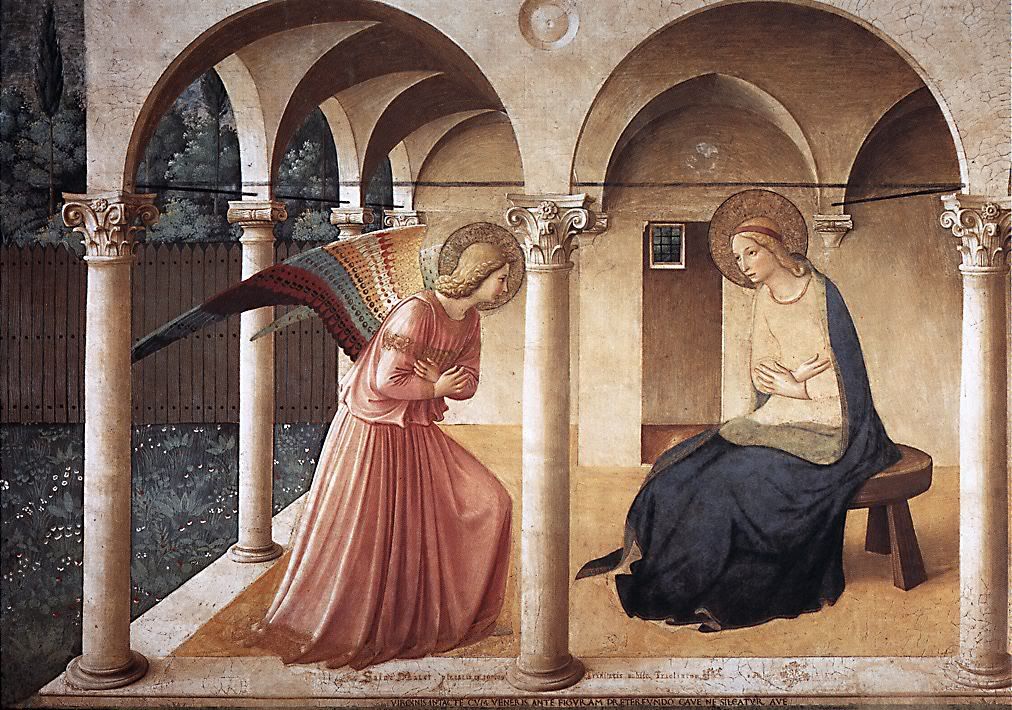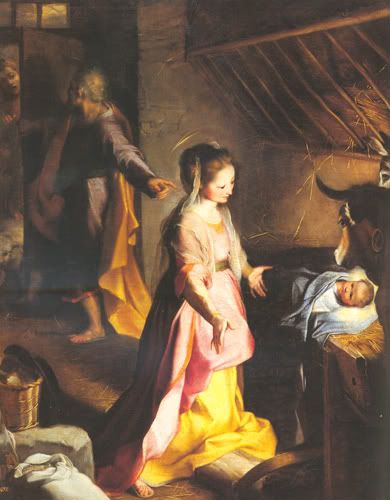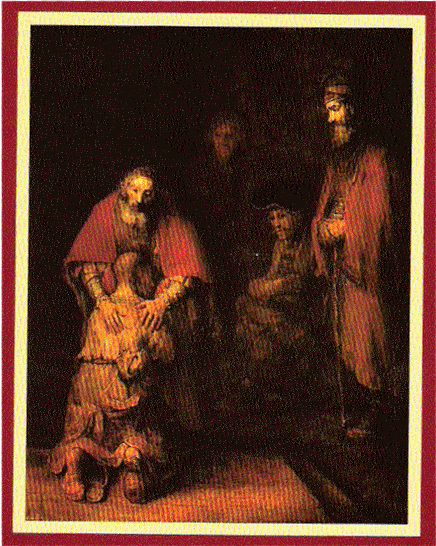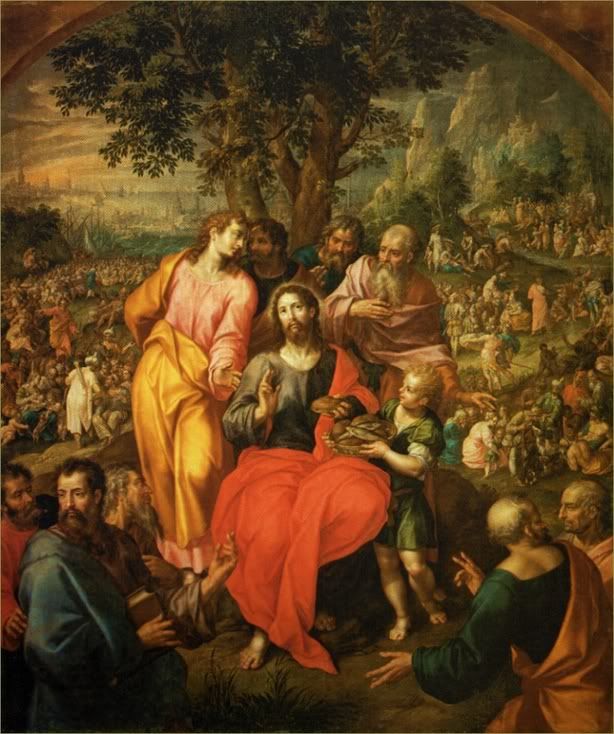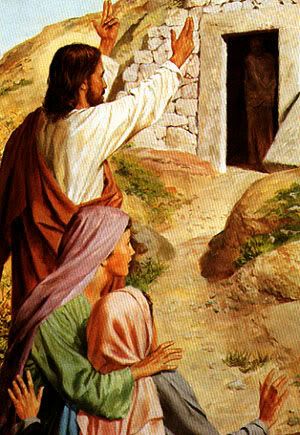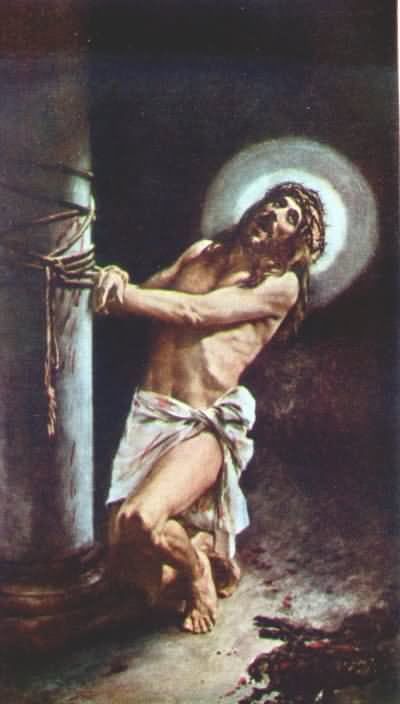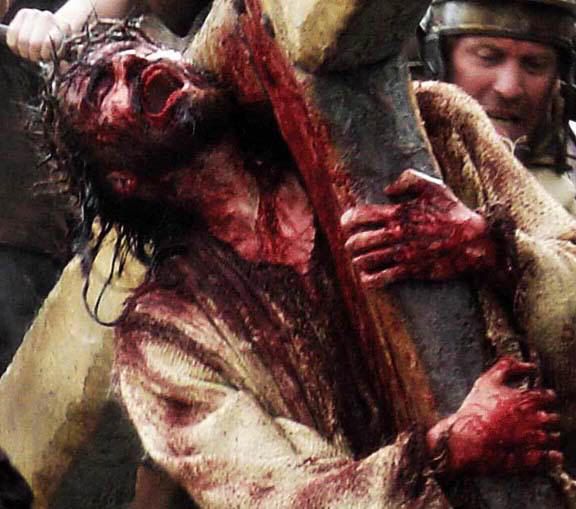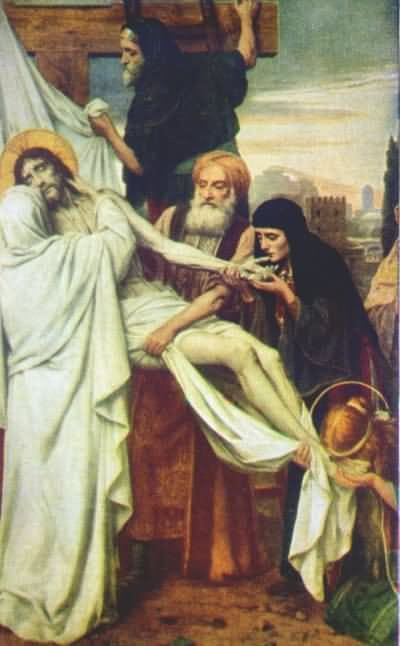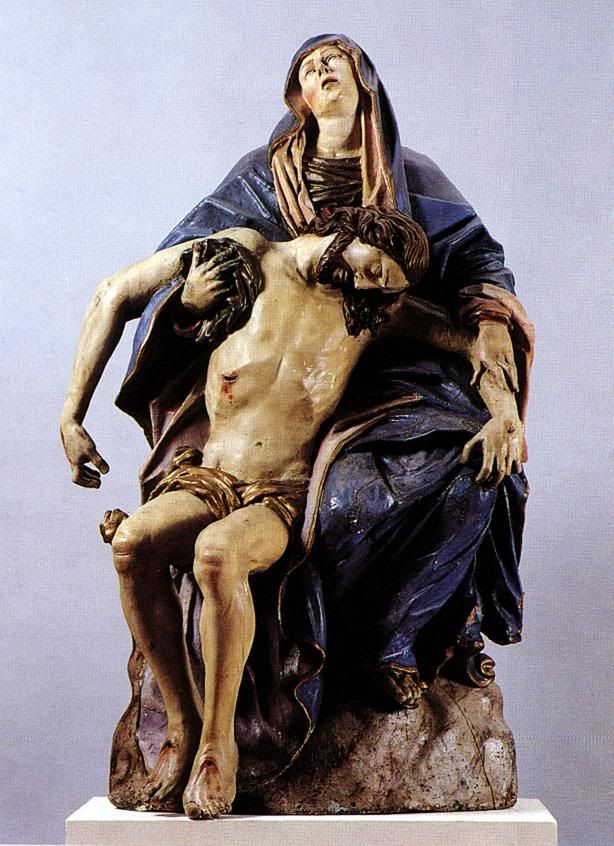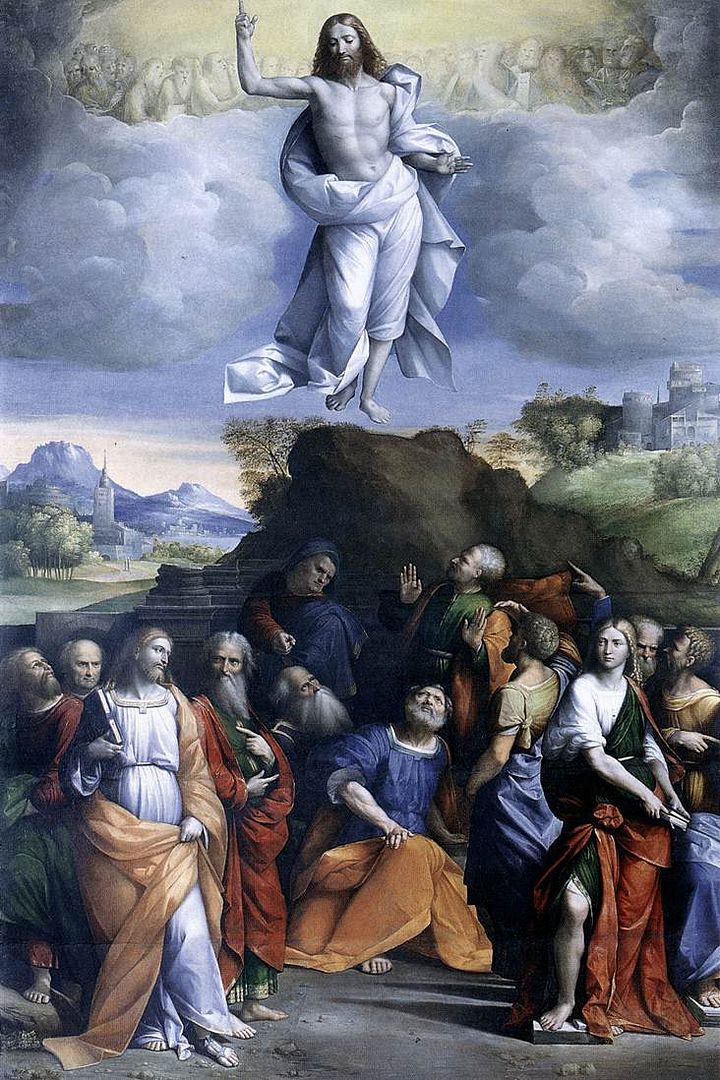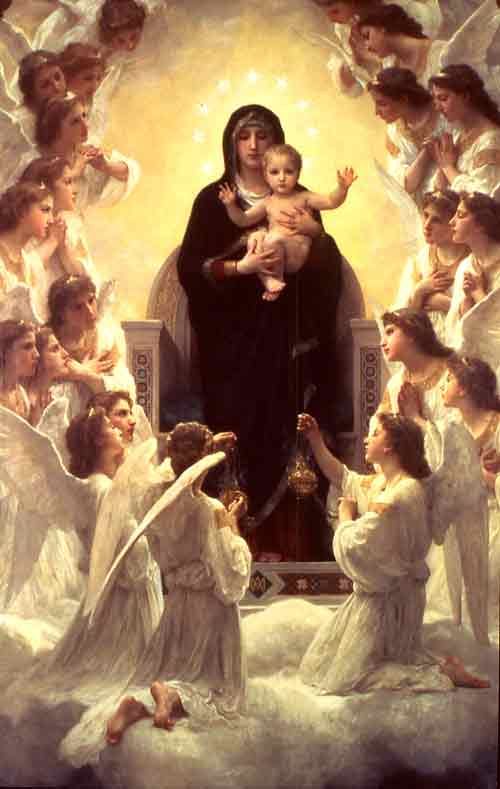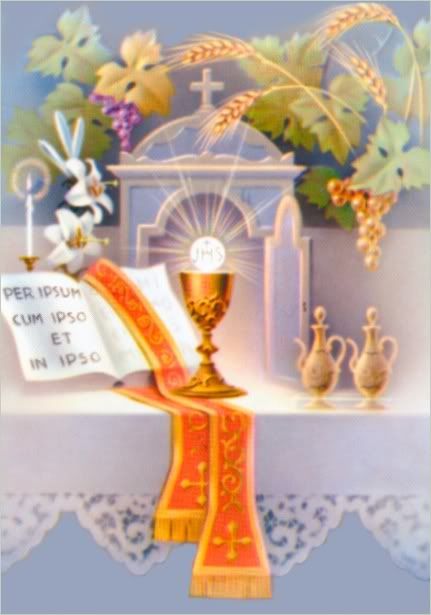Saturday, October 01, 2005
A Really Close Finish
The Sox went into last night's game with the Yankees one game back, and won, tying them for first place in the AL East.
But now, in the 8th, they are behind 7-3. If they can pull off one more win, today or tomorrow, there will be a one-game playoff Monday in New York for the AL East.
Go Red Sox!!!!!
But now, in the 8th, they are behind 7-3. If they can pull off one more win, today or tomorrow, there will be a one-game playoff Monday in New York for the AL East.
Go Red Sox!!!!!
Today's Catholic Cultural Heritage Image
The photos available don't do this item justice. But the baptismal font cover at St. Mary's Ufford, Suffolk is a true survivor. It lost some of its statuary during the reformation, but its delicate Gothic wood carving is a splendid work of an unknown 15th Century artist.
Why a cover for the baptismal font? The same reason Bibles in church had chains on them: theft. Holy Water was in great demand, as people were in the habit of sprinkling this sacramental about the house and about themselves, their animals, their crops, their possessions. The church was called St. Mary of the Assumption before the protestant rebellion, but is now more typically called just St. Mary's, as the church is Anglican.

Detail of the font cover with new statues

This puts the font cover in context and gives you a better idea of its height. It extends to the ceiling (or as British sources call it, the roof; which we Americans reserve for the exterior). The bottom sections of the cover can be pushed up inside the top, like sections of a telescope. Quite ingenious!
I know the photos are a little dark, but that was the best I could find today. The illustrations in the books on English parish churches I have been reading are all in black and white, which I think would be even less useful in showing the glory of this Catholic artifact.
Here is a better one!

The pelican perched 18 feet up the font cover, at its top.
Why a cover for the baptismal font? The same reason Bibles in church had chains on them: theft. Holy Water was in great demand, as people were in the habit of sprinkling this sacramental about the house and about themselves, their animals, their crops, their possessions. The church was called St. Mary of the Assumption before the protestant rebellion, but is now more typically called just St. Mary's, as the church is Anglican.

Detail of the font cover with new statues

This puts the font cover in context and gives you a better idea of its height. It extends to the ceiling (or as British sources call it, the roof; which we Americans reserve for the exterior). The bottom sections of the cover can be pushed up inside the top, like sections of a telescope. Quite ingenious!
I know the photos are a little dark, but that was the best I could find today. The illustrations in the books on English parish churches I have been reading are all in black and white, which I think would be even less useful in showing the glory of this Catholic artifact.
Here is a better one!

The pelican perched 18 feet up the font cover, at its top.
Saint Theresa of Lisieux

Saint Theresa of the Child Jesus, or Theresa of Lisieux, as she is more commonly known, actually died on September 30th. Her feast was October 3rd for many years, before it was moved to October 1st. I assume her feast was not moved to September 30th, because that would put two major saints on the same day (Saint Jerome).
What many don't know about her (I did not until the last year) is that her parents are candidates for sainthood as well. I may be wrong, but I think this would qualify the Martins as the only modern family of saints (not including martyrs, where there might well be whole families martyred at once).
Here is a biography of The Little Flower.
I have never read The Story Of A Soul, but I plan to put it on my list of books to read.
October

October's image from Les Tres Riches Heures du Duc de Berry shows, not harvesting, as goes on in America in October, but tilling and sowing! Explanation: this is the time in Europe (which is more temperate than, say, New England) to sow both legumes, and the winter wheat crop. The beans sown in October were a vitally important part of the diet of Europeans come late winter. With stocks of meat slaughtered in November exhausted before spring, or no longer edible, legumes were a very important source of protein. The Europeans did use scarecrows. See the "archer" in the background? He's a scarecrow, and not a very effective one, as the birds are feasting on the newly sewn seeds.
Important feasts celebrated in October include:
1st St. Theresa of Lisieux
2nd Guardian Angels
4th St. Francis of Assisi
5th St. Faustina Kowalska
7th Our Lady of the Rosary (Lepanto)
9th St. Denis
13th St. Edward the Confessor
15th St. Terese of Avila
16th St. Gall and St. Gerard Majella
17th St. Margaret Mary Alacoque
18th St. Luke the Evangelist
19th North American Martyrs
21st St. Gaspare de Bufalo
22nd St. Mary Salome
23rd St. John of Capistrano
25th Forty Martyrs of England and Wales, and SS. Crispin and Crispinian
28th St. Jude and St. Simon
31st All Hallow's Eve (Halloween)
October is dedicated to the Holy Rosary of the Blessed Virgin Mary, the feast of which is on October 7th.
Our Holy Father Pope Benedict XVI's intentions for the month of October are:
General - For all Christians facing the threat of secularism: may they trust in God and be courageous witnesses of faith and hope.
Missionary - For all Christians: besides praying for the missions may they also support missionary activity with material offerings.
The First Saturday of the month is October 1st.
The First Friday is October 7th.
Friday, September 30, 2005
Coming Later In October
Some people have said that we know how to do holidays and traditional observances right here at Recta Ratio.
Well, I've been gearing up for Hallowmas and the Days of the Dead. Starting in late October and carrying on well past All Souls' Day, almost to the doorstep of Thanksgiving, you can expect a barrage of postings on cadaver tombs, memorial brasses, dirges, images of the Holy Souls in Purgatory, bone chapels, chantry chapels, ossuaries. going a'souling, prayers for the Poor Souls, the Ars Moriendi, the Office of the Dead, the Dance Macabre, prayers for a holy, happy death, recipes, and ghost stories with an old New England flavor (for All Hallow's Eve, of course).
So have the hot mulled cider and your rosary ready starting around October 20th or so.
Well, I've been gearing up for Hallowmas and the Days of the Dead. Starting in late October and carrying on well past All Souls' Day, almost to the doorstep of Thanksgiving, you can expect a barrage of postings on cadaver tombs, memorial brasses, dirges, images of the Holy Souls in Purgatory, bone chapels, chantry chapels, ossuaries. going a'souling, prayers for the Poor Souls, the Ars Moriendi, the Office of the Dead, the Dance Macabre, prayers for a holy, happy death, recipes, and ghost stories with an old New England flavor (for All Hallow's Eve, of course).
So have the hot mulled cider and your rosary ready starting around October 20th or so.
Today's Catholic Cultural Heritage Image
This is an English thing.

The canopied sedilia and piscina.
The what?
You know how, in the Traditional Latin Mass, the priest and his deacons sit on chairs or a bench off to the side of the sanctuary? Well, the three right-hand openings are places for them to sit from your typical Gothic English parish church of the blessed days before the protestant rebellion. The left-hand opening, the piscina, is a shelf to hold Mass books and sacred vessels not needed at the altar at the moment. The whole is framed in an architectural canopy. This arrangement is in a good state of preservation here at what has been, for almost 500 years now, the Anglican All Saints Church, Weston Longville, Norfolk. These are on the south wall of the chancel, or as we call it now, the sanctuary.

The canopied sedilia and piscina.
The what?
You know how, in the Traditional Latin Mass, the priest and his deacons sit on chairs or a bench off to the side of the sanctuary? Well, the three right-hand openings are places for them to sit from your typical Gothic English parish church of the blessed days before the protestant rebellion. The left-hand opening, the piscina, is a shelf to hold Mass books and sacred vessels not needed at the altar at the moment. The whole is framed in an architectural canopy. This arrangement is in a good state of preservation here at what has been, for almost 500 years now, the Anglican All Saints Church, Weston Longville, Norfolk. These are on the south wall of the chancel, or as we call it now, the sanctuary.
Good Analysis
Nobis Quoque Peccatoribus provides us with a good, cogent analysis of the ramifications of a "universal indult" for the TLM, or reconciliation with the SSPX.
It All Comes Down to the Final Weekend
The Red Sox slipped a game behind the Yankees this week. And they host them for a three-game series at Fenway, the last three games of the regular season. If the Sox win 2 of the 3, there will be a one-game playoff in New York Monday.
GO RED SOX!!!
GO RED SOX!!!
St. Blog's May Have A Templar Dame of Devotion Soon
Rachel of The History Buff's Traditional Catholic Blog has decided to start the Militia Templi's novitiate. I am sure we all pray for her success in this.
Dante's Inferno Quiz
The Dante's Inferno Test has sent you to Purgatory!
Here is how you matched up against all the levels:
Take the Dante's Divine Comedy Inferno Test
Here is how you matched up against all the levels:
| Level | Score |
|---|---|
| Purgatory (Repenting Believers) | Very High |
| Level 1 - Limbo (Virtuous Non-Believers) | Very Low |
| Level 2 (Lustful) | Moderate |
| Level 3 (Gluttonous) | High |
| Level 4 (Prodigal and Avaricious) | High |
| Level 5 (Wrathful and Gloomy) | Moderate |
| Level 6 - The City of Dis (Heretics) | Very Low |
| Level 7 (Violent) | Low |
| Level 8- the Malebolge (Fraudulent, Malicious, Panderers) | High |
| Level 9 - Cocytus (Treacherous) | Low |
Take the Dante's Divine Comedy Inferno Test
Chant CD
You might be interested in Matthew McDevitt's chant CDs, recorded at Saint Thomas aquinas Seminary.
John Zmirak Has A Book Out
The Bad Catholic's Guide To Good Living.

Father Rutler liked it.
Note: Don't confuse John's work with a dissenting Catholic's blog of a similar name.

Father Rutler liked it.
Note: Don't confuse John's work with a dissenting Catholic's blog of a similar name.
That List
Over at Save Holy Trinity Yahoo Group, the list of Boston diocesan priests who signed the letter urging Cardinal Law to resign and who are no longer in the positions they then occupied is getting a lot of attention. The Boston Herald published it. It is on Page 2 of the article.
It makes it look as if the "evil" Archdiocese (and I would agree that it is often wrong-headed, heavy-handed, insensitive, badly managed, and too liberal) is out to "get" the priests who signed the letter. But a lot of the signatories (not all) were liberal dissenters who hated Cardinal Law anyway. Others were ready to retire, had nothing to lose, and have done so. Many have been transferred, as priests often are. Many were in parishes that have been closed (that is where you stick dissenting priests, in tiny, unhealthy parishes, not in thriving orthodox ones). now why would the Archbishop want to take out the guys who helped him get the promotion?
Dom Bettinelli does a good job dealing with this.
As a commenter over at Bettnet said, "If only...".
In fact, the Archdiocese is more likely to go after orthodox traditional parishes, priests, and parents, as seen in the whole Talking About Touching fiasco, the refusal to allow the FSSP to operate in Boston, and in the coming battle to close Holy Trinity, Boston's Ecclesia Dei Indult parish.
It makes it look as if the "evil" Archdiocese (and I would agree that it is often wrong-headed, heavy-handed, insensitive, badly managed, and too liberal) is out to "get" the priests who signed the letter. But a lot of the signatories (not all) were liberal dissenters who hated Cardinal Law anyway. Others were ready to retire, had nothing to lose, and have done so. Many have been transferred, as priests often are. Many were in parishes that have been closed (that is where you stick dissenting priests, in tiny, unhealthy parishes, not in thriving orthodox ones). now why would the Archbishop want to take out the guys who helped him get the promotion?
Dom Bettinelli does a good job dealing with this.
As a commenter over at Bettnet said, "If only...".
In fact, the Archdiocese is more likely to go after orthodox traditional parishes, priests, and parents, as seen in the whole Talking About Touching fiasco, the refusal to allow the FSSP to operate in Boston, and in the coming battle to close Holy Trinity, Boston's Ecclesia Dei Indult parish.
Another Departure
The Catholic Monarchist, one of my daily reads, and an inspiration for some of the Catholic cultural heritage work I do here is calling it quits.
He will be missed.
He will be missed.
Looking Ahead
In case you are interested in fulfilling the requirements of the First Saturday Devotion, tomorrow is not just October 1st. It is also the First Saturday. An easy thing to miss when it does not follow the First Friday, which does not happen in October until a week from today.
I'm Slow In Comprehending Some Things
I'm sure most of you are light years ahead of me on this, but one thing that came to my attention while reading Eamon Duffy's excellent The Stripping of the Altars: Traditional Religion In England, 1400-1580, is that all these innovations that have crept into the reception of Communion in the Mass, reception in the hand, reception standing, reception from a lay minister, reception under both Species, ARE PROTESTANT THINGS. They are not "new." They are only new in the sense that they were never foisted upon Roman Catholics before about 1975. The English protestant rebels were pushing reforms like this in the 1550s and 1580s.
I instinctively disliked and avoided all of them when they came my way, but only because they were innovations (my childhood home parish, which I attended for 30 years, was slower than most in adopting these things: they did not pick up steam there until after 1980-85) and my conservative nature curls the lip at innovations. I didn't realize they were protestant, having grown up in a family traditional enough to have never even considered attending a protestant service under any circumstances.
So light finally dawns, even on the back of Mount Rushmore.
Why should Roman Catholics in the early 21st Century make use of practices favored by protestant rebels of the 16th Century? Is that ecumenism? They get their way, but only after 400 years? Why grant it at all? Next time I take the Blessed Sacrament (I am now by no means a weekly communicant any longer, though I attend weekly: I am still not comfortable enough with confession for it to be easy for me, and weekly confession is an ordeal I can't see happening now) I'll certainly do so in the most distinctively Catholic manner: kneeling, at a rail, on the tongue, silently, reverently, only under the Species of the Host, and from a priest.
I instinctively disliked and avoided all of them when they came my way, but only because they were innovations (my childhood home parish, which I attended for 30 years, was slower than most in adopting these things: they did not pick up steam there until after 1980-85) and my conservative nature curls the lip at innovations. I didn't realize they were protestant, having grown up in a family traditional enough to have never even considered attending a protestant service under any circumstances.
So light finally dawns, even on the back of Mount Rushmore.
Why should Roman Catholics in the early 21st Century make use of practices favored by protestant rebels of the 16th Century? Is that ecumenism? They get their way, but only after 400 years? Why grant it at all? Next time I take the Blessed Sacrament (I am now by no means a weekly communicant any longer, though I attend weekly: I am still not comfortable enough with confession for it to be easy for me, and weekly confession is an ordeal I can't see happening now) I'll certainly do so in the most distinctively Catholic manner: kneeling, at a rail, on the tongue, silently, reverently, only under the Species of the Host, and from a priest.
It Is Done
He is Chief Justice Roberts, now.
I see the news shifting a great deal on the second pick, with new names not mentioned for the first pick coming to the forefront, and my own favorites, like Judge Edith Jones, Judge Emilio Garza, Judge J. Michael Luttig, Judge J. Harvie Wilkinson, and Professor Mary Ann Glendon, being shunted to the background.
One thing I am almost certain of, is that this nominee will not be a Catholic, unless he or she is an Hispanic. I also doubt it will be a white male of European ancestry.
I just hope it is not Attorney general Gonzales, or some stealth nominee who will prove to be another Souter or Kennedy, or worse. While Republicans hold he majority, the President ought to be bold. If he wants to reward the Hispanic community, a large percentage of which voted for him last year, I can see no better way to do it than nominating Judge Garza, a solid, reliable conservative, and the son of Hispanic immigrants.
I see the news shifting a great deal on the second pick, with new names not mentioned for the first pick coming to the forefront, and my own favorites, like Judge Edith Jones, Judge Emilio Garza, Judge J. Michael Luttig, Judge J. Harvie Wilkinson, and Professor Mary Ann Glendon, being shunted to the background.
One thing I am almost certain of, is that this nominee will not be a Catholic, unless he or she is an Hispanic. I also doubt it will be a white male of European ancestry.
I just hope it is not Attorney general Gonzales, or some stealth nominee who will prove to be another Souter or Kennedy, or worse. While Republicans hold he majority, the President ought to be bold. If he wants to reward the Hispanic community, a large percentage of which voted for him last year, I can see no better way to do it than nominating Judge Garza, a solid, reliable conservative, and the son of Hispanic immigrants.
Saint Jerome

Saint Jerome In Penance, from the Hours of Henry VIII, by Jean Poyet, c. 1500. Interestingly, in many medieval depictions, Saint Jerome is depicted with a cardinal's clothing, though the office did not exist in his time.
"The measure of our advancement in the spiritual life should be taken from the progress we make in the virtue of mortification; for it should be held as certain that the greater violence we shall do ourselves in mortification, the greater advance we shall make in perfection."
The Golden Legend on Saint Jerome.
And a good biography from Catholic OnLine.
Thursday, September 29, 2005
Michaelmas

Today is Michaelmas, the Feast of Saint Michael and All Angels. Saint Michael, perhaps the greatest of the Archangels, is the protector of the Church.
Michaelmas was a quarterly rent day in England and Ireland. It is the start of the university term at both Oxford and Cambridge. Presents and feasts featuring geese were very much the custom at this time of year. Roast goose with sage and onion stuffing would go down very well right now, I can assure you.
We have the absurdity, due to the Migratory Birds Act, of having lots and lots of geese around the Boston area year-round making a great nuisance of themselves, and no ability to harvest them. The recent mild winters, and the fact that many people feed them have led thousands and thousands of Canada geese to make Boston their permanent home. And yet, because of the law (designed to protect migratory birds, not birds that live in one area year-round) no one can harm these creatures, who would be quite savory main courses on the plates of thousands of families.
So, roast a goose for Michaelmas, so long as it is not a Canada goose.
Signifer Sanctus Michael repraesentet eas in lucem sanctam.
Saint Michael the Archangel,
Defend us in battle.
Be our protection against the
Wickedness and snares of the devil.
May God rebuke him,
We humbly pray.
And do thou,
O Prince of the Heavenly Host,
By the Divine Power,
Thrust into Hell
Satan and all the other evil spirits
which prowl about the world,
Seeking the ruin of souls.
Amen.
Saint Michael also has another important duty. He is the principal usher of newly deceased souls to heaven. Medieval Books of Hours, as part of the Office of the Dead, often included a deathbed scene, where the soul of the just-departed leaves the body, and St. Michael has to fight off various demons who try to snatch the soul and carry it off to Hell. St. Michael is, therefore, one of the saints whose intercession is customarily invoked for a happy death, along with Our Blessed Lady, St. Joseph, and St. Peter.

St. Michael in action rescuing a soul from waiting demons.
Wednesday, September 28, 2005
Broader Availability of the Traditional Latin Mass
Cardinal Medina says it is coming soon.
I put the SSPX issue to one side. In my humble opinion, the Latin Mass ought to be more available as a matter of justice. The revocation of the excommunications on the leaders of the SSPX can come, too, but that would be a matter of charity, not justice. I am sure it has not gone unnoticed in the Vatican that, if Ecclesia Dei indult Masses are more widely available (if, say the Archdiocese of Boston were to host, not one, but 4-5 every week, regionalized, in stable and suitable locations and at convenient times, and the same for every Archdiocese in the world) the wind would come off the SSPX sails, and 70-80% of their attendees would be at the indult Masses.
It sounds as if the Vatican is floating many trial balloons on the coming broadening of the TLM's availability. I wonder if they are keeping track of who is welcoming the news, and who is trying to shoot the balloons down.
I put the SSPX issue to one side. In my humble opinion, the Latin Mass ought to be more available as a matter of justice. The revocation of the excommunications on the leaders of the SSPX can come, too, but that would be a matter of charity, not justice. I am sure it has not gone unnoticed in the Vatican that, if Ecclesia Dei indult Masses are more widely available (if, say the Archdiocese of Boston were to host, not one, but 4-5 every week, regionalized, in stable and suitable locations and at convenient times, and the same for every Archdiocese in the world) the wind would come off the SSPX sails, and 70-80% of their attendees would be at the indult Masses.
It sounds as if the Vatican is floating many trial balloons on the coming broadening of the TLM's availability. I wonder if they are keeping track of who is welcoming the news, and who is trying to shoot the balloons down.
Kung Spared An Auto-Da-Fe Because Of Environmental Concerns
Funny take on the Father Kung/Pope Benedict meeting provided by Hilary at The Devout Life.
I haven't mentioned it because it wasn't really a substantive meeting. The two are old faculty collegues.
I haven't mentioned it because it wasn't really a substantive meeting. The two are old faculty collegues.
Well, It Certainly Isn't A "Diplomatic" Pick
But then, it doesn't have to be, does it? The important thing is to finally get Our Lady Help of Christians in Newton a pastor who will preach "Christ and Him Crucified," not the Gospel according to the Boston Globe, the VOTF, "Catholics" For a Free Choice, or the moribund mainline protestant churches.
There are issues with Father Coyne, of course. His tenure as spokesman for the Archdiocese was marked with seemingly callous insensitivity to parents, and victims. But was that Father Coyne, or his superiors?
In a sense, Father Coyne may be just what a borderline "rebel" parish like OLHC may need the most, an intelligent priest who takes his orders from the Archbishop and from Rome, not from Hans Kung and Father McBrien. A company man, maybe the ultimate company man, assigned to a rebel parish.
It is a slap. It is obviously intended to be. And many more ultra-liberal parishes need just this kind of slap.

Good luck to Father Coyne, who has a tough job ahead, catechizing a rebel parish from whatever Father Cuenin was preaching all these years to orthodox Catholicism.
There are issues with Father Coyne, of course. His tenure as spokesman for the Archdiocese was marked with seemingly callous insensitivity to parents, and victims. But was that Father Coyne, or his superiors?
In a sense, Father Coyne may be just what a borderline "rebel" parish like OLHC may need the most, an intelligent priest who takes his orders from the Archbishop and from Rome, not from Hans Kung and Father McBrien. A company man, maybe the ultimate company man, assigned to a rebel parish.
It is a slap. It is obviously intended to be. And many more ultra-liberal parishes need just this kind of slap.

Good luck to Father Coyne, who has a tough job ahead, catechizing a rebel parish from whatever Father Cuenin was preaching all these years to orthodox Catholicism.
Oh, And Thank You
To everyone who e-mailed about my headache. I am feeling much better now.
Hey, did you know that 500 mg. Extra Strength Tylenol now comes in a tiny cherry candy-coated variety. Three of them (at once) dulled the pain enough for me to finish The Stripping of the Altars yesterday.
Hey, did you know that 500 mg. Extra Strength Tylenol now comes in a tiny cherry candy-coated variety. Three of them (at once) dulled the pain enough for me to finish The Stripping of the Altars yesterday.
Traditional Anglicans To Seek Communion With Rome

Anglican Use Roman Catholic Mass At Our Lady of Atonement

If this works out, it could mean that the traditionalist Anglicans (and I was paging through a national directory of their parishes in the library recently: they have quite a few parishes, scattered, of course) will become a much bigger force in the Roman world, supplementing the existing Anglican-Use parishes, perhaps even graduating to the status of a seperate rite, like the Byzantine Rite. Read more about it here (you have to scroll down to the second news item).
I hope and pray this works out. A part of the protestant rebellion of the 16th century reversed! And there is a group of Lutherans in contact with Rome about entering into Communion with the Holy See and the Successor of Saint Peter, too.
Hat tip to The Catholic Monarchist.
And while you are there, scroll down to his next post on the various scapulars.
Saint Wenceslaus
But I'm always jumping the gun on Christmas. But this time, I'm innocent. Today is the feast of Saint Wenceslaus.
Actually, my reading of Visits To the Blessed Sacrament and the Blessed Virgin Mary by Saint Alphonsus Liguori (I've recently begun incorporating his method for visits with my Eucharistic Adoration routine) brought an explanation for the obscure text of one of my favorite Christmas carols.
Now I understand the context of the verses of Good King Wenceslaus!
Never read the story before.

A brief biography of Saint Wenceslaus can be found here.
Catholic Forum features a brief account of his murder by his own brother.
Actually, my reading of Visits To the Blessed Sacrament and the Blessed Virgin Mary by Saint Alphonsus Liguori (I've recently begun incorporating his method for visits with my Eucharistic Adoration routine) brought an explanation for the obscure text of one of my favorite Christmas carols.
St. Francis of Assisi used to go to communicate all his labors and undertakings to Jesus in the Most Holy Sacrament. But tender indeed was the devotion of St. Wenceslaus, duke of Bohemia, to the Most Holy Sacrament. This holy king was so enamored of Jesus there present, that he not only gathered the wheat and grapes, and made the hosts and wine with his own hands, and then gave them to be used in the Holy Sacrifice, but he used, even during the winter, to go at night to visit the church in which the Blessed Sacrament was kept. These visits enkindled in his beautiful soul such flames of divine love, that their ardor imparted itself even to his body, and took from the snow on which he walked, its wonted cold: for it is related that the servant who accompanied him in these nightly excursions, having to walk through the snow, suffered much from the cold. The holy king, on perceiving this, was moved to compassion, and commanded him to follow him, and only to step in his foot-marks; he did so, and never afterwards felt the cold.
Now I understand the context of the verses of Good King Wenceslaus!
Never read the story before.

"Sire the night is darker now, and the wind blows stronger
Fails my heart, I know not how. I can go no longer."
"Mark my footsteps my good page. Tread thou in them boldly
Thou shalt find the winter's rage freeze thy blood less coldly."
In his master's steps he trod, where the snow lay dinted
Heat was in the very sod which the saint had printed
Therefore Christian men be sure, wealth or rank possessing,
Ye who now will bless the poor, shall yourselves find blessing.
A brief biography of Saint Wenceslaus can be found here.
Catholic Forum features a brief account of his murder by his own brother.
Tuesday, September 27, 2005
I'm Taking Today Off
Sorry about that, chief.
Massive headache, almost like a migraine. And the fact that my connection today is slower than molasses on a cold winter's day (though not the Great 1919 Boston Molasses Flood molasses, which was hauling tail through the streets of the North End at a reported 35 mph) is not helping my mood.
Rest, quiet, and over the counter pain meds are the order of the day.
See you on the flip side.
Massive headache, almost like a migraine. And the fact that my connection today is slower than molasses on a cold winter's day (though not the Great 1919 Boston Molasses Flood molasses, which was hauling tail through the streets of the North End at a reported 35 mph) is not helping my mood.
Rest, quiet, and over the counter pain meds are the order of the day.
See you on the flip side.
Monday, September 26, 2005
Anglicans Slide Further Down the Slippery Slope
Married priests. Divorced priests. Divorced bishops. Gay priests. Gay bishops. Gay bishops married to their catamites. Women priestesses. Married women priestesses. Divorced women priestesses. Women bishops. Now, transgendered "priests."
Today's Catholic Cultural Heritage Images
I have no idea where these images are from, except that the very simple church exterior that houses them looks alpine. The figures appear to be 17th or 18th century. I stumbled across the index of a site while looking for something else. Ah, serendipity!

A very baroque crucifixion scene, from and altarpiece, with cherubs collecting the Most Precious Blood.

The Sanctuary with the above reredos.

A closer look at the high altar.
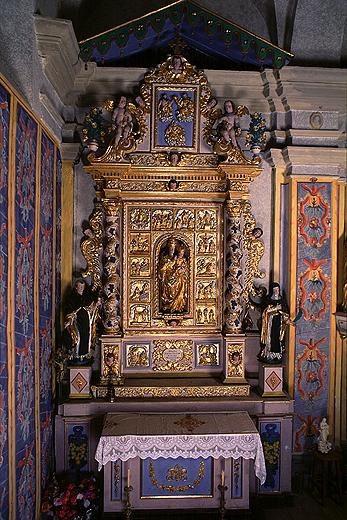
Side altar to Our Lady of Mount Carmel(?). That is a guess, but the statue on our right, I take to be St. Teresa of Avila. And the golden or brownish robes of Our Blessed Lady makes me think Our Lady of Mount Carmel. But I can't see any scapulars.

Here is a close-up of that side altar, but it leaves me none the wiser. There are twelve scenes involving the Passion and Resurrection and Ascension surrounding the central images, but they are neither the Mysteries of the Rosary nor the Stations of the Cross, not, I think, the Sorrows of Our Blessed Lady.

Well, here is the simple exterior of this church. I'm thinking Northern Italy, Southern Germany, or Austria. If anyone can say, "Tom, you cretin, it is St. X, the very well-known pilgrimage place that I have been to a thousand times!" please e-mail me so I can share the identity of this interesting place.

A very baroque crucifixion scene, from and altarpiece, with cherubs collecting the Most Precious Blood.

The Sanctuary with the above reredos.

A closer look at the high altar.

Side altar to Our Lady of Mount Carmel(?). That is a guess, but the statue on our right, I take to be St. Teresa of Avila. And the golden or brownish robes of Our Blessed Lady makes me think Our Lady of Mount Carmel. But I can't see any scapulars.

Here is a close-up of that side altar, but it leaves me none the wiser. There are twelve scenes involving the Passion and Resurrection and Ascension surrounding the central images, but they are neither the Mysteries of the Rosary nor the Stations of the Cross, not, I think, the Sorrows of Our Blessed Lady.

Well, here is the simple exterior of this church. I'm thinking Northern Italy, Southern Germany, or Austria. If anyone can say, "Tom, you cretin, it is St. X, the very well-known pilgrimage place that I have been to a thousand times!" please e-mail me so I can share the identity of this interesting place.
New Blog, Familiar Blogger
Rick Lugari has closed down (but not deleted) Unum Sanctam, but has started a new blog. Go visit him at De Civitate Dei.
I don't really understand the concept of starting over with a new blog. I've changed Recta Ratio's name, changed the template, tweaked the html, added images, had comments, got rid of comments, toyed with the idea of changing host, and switched emphasis and subject matter as the spirit moves me. But my blog is my blog. But it must work for some people. Well, each to his own.
I don't really understand the concept of starting over with a new blog. I've changed Recta Ratio's name, changed the template, tweaked the html, added images, had comments, got rid of comments, toyed with the idea of changing host, and switched emphasis and subject matter as the spirit moves me. But my blog is my blog. But it must work for some people. Well, each to his own.
Sunday, September 25, 2005
Today's Catholic Cultural Heritage Image

In honor of Notre Dame's new president, this is the main altar at the Basilica of the Sacred Heart.
Notre Dame's website describes the altar thus:
The main altar was purchased by Rev. Edward Sorin, C.S.C., from a firm in Paris whose director promised an altar "flowing with gold." Before arriving at Notre Dame, the altar was displayed at the Philadelphia Centennial Exposition in 1876 where it won a first for design.
The French flamboyant Gothic style corresponds to the style imitated in the stained glass windows. A number of slender columns sustain the city of Jerusalem tabernacle which is crowned with the Lamb of God holding the cross. Its doors are decorated with plates bearing the names of the 12 tribes of Israel. Each of the 12 gates is guarded by an angel; 12 foundations, each bearing the name of one of the apostles, support the wall.
Beneath the altar are the relics of Saint Marcellus, a third century centurion, beheaded for refusing to serve in the Roman army. In the altar stone are relics of Saints Stephen and Sebastian as well as other martyrs of that period.
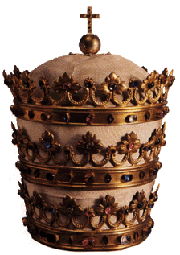
And the tiara that was used by Pope Pius IX, and is in the custody of Notre Dame.
Syon Abbey
Syon Abbey is a schismatic Benedictine offshot that apparently does not recognize Vatican II. However, the order has constructed a lovely Gothic monastery in Virginia.
Tip of the biretta to Father Tucker.
Tip of the biretta to Father Tucker.
Fresh Cider Time!!!

There are few earthly delights that, in my estimation, exceed that derived from consuming fresh apple cider. With the apple crop coming in nicely these last few weeks, this year's cider apple crop is hitting the market now. Aside from being a necessary ingredient of cider donuts, boiled cider pie, mincemeat, and apple butter, it is also required for Pork Loin Roast with Apples, a Christmas-time staple.

But best of all is quaffing it straight and cold in the early fall. In a couple of months, after Thanksgiving, it will be mulled. And at Christmas, it is needed for both Spiced Punch and Wassail.
From Chambers' Book of Days for September 25th
CIDER-MAKING
Debarred by the adverse influences of climate from the profitable cultivation of the vine, the northern nations of Europe have endeavoured to supply this deficiency by the manufacture of exhilarating liquors from fruits and grains of various kinds, more congenial to their soil and skies. Of these rivals to the grape, with the exception of John Barleycorn and his sons, there is none which may more fairly claim to contest the palm of agreeableness and popularity than the apple and her golden-haired daughter, the bright and sparkling cider, whom some ardent admirers have even exalted to a level with the regal vintage of Champagne. Hear how John Philips, in his poem of Cider, eulogises the red-streak apple and its genial produce:
'Let every tree in every garden own
The Red-streak as supreme, whose pulpous fruit
With gold irradiate, and vermilion shines
Tempting, not fatal, as the birth of that
Primeval interdicted plant that won
Fond Eve in hapless hour to taste, and die.
This, of more bounteous influence, inspires
Poetic raptures, and the lowly
Muse Kindles to loftier strains; even I perceive
Her sacred virtue. See! the numbers flow
Easy, whilst, cheer'd with her nectareous juice,
Hers and my country's praises I exalt.
Hail Herefordian plant, that dost disdain
All other fields! Heaven's sweetest blessing, hail!
Be thou the copious matter of my song,
And thy choice nectar; on which always waits
Laughter, and sport, and care-beguiling wit,
And friendship, chief delight of human life.
What should we wish for more? or why, in quest
Of foreign vintage, insincere, and mixt,
Traverse th' extremest world? why tempt the rage
Of the rough ocean? when our native glebe
Imparts, from bounteous womb, annual recruits
Of wine delectable, that far surmounts
Gallic, or Latin grapes, or those that see
The setting sun near Calpes' towering height.
Nor let the Rhodian, nor the Lesbian vines
Vaunt their rich Must, nor let Tokay contend
For sovereignty; Phanaeus self must bow
To th' Ariconian vales.'
Like hop-picking in the east, the gathering of apples, for cider, forms one of the liveliest and most interesting of rural operations throughout the year in the western counties of England. These comprise mainly Hereford, Monmouth, and Gloucester shires, Somerset and Devon, the first and last counties more especially representing the two great cider districts of England, and also two separate qualities of the liquor, Herefordshire being noted par excellence for sweet, as Devonshire is for rough cider. Both descriptions, however, are made in the two counties. In the sweet cider, the object of the maker is to check the vinous fermentation as far as possible, so as to prevent the decomposition of the saccharine matter, which in the rough cider is more or less destroyed. The cider lauded by Philips in such encomiastic terms, is the sweet Herefordshire cider; but as a native of the west midland counties, a due allowance must be made for local predilection. It, nevertheless, enjoys a deservedly high reputation, and it is stated as a positive fact that an English peer, when ambassador in France, used frequently to palm it on the noblesse as a delicious wine.
In the manufacture of cider, those apples are preferred which are of a small size and have an acid or astringent taste. Red and yellow are the favourite colours, green being avoided as producing a very poor quality of liquor. Where cider is made in small quantities, or where it is desired to have it of a specially fine description, the apples are gathered by the hand when thoroughly ripe, care-fully picked, and any rotten portions that may appear, cut away.
For general purposes, the fruit is beaten from the trees by the aid of long poles, and collected in baskets beneath, by women and children. It is then spread out in heaps in the open air, and remains exposed to the weather till it becomes mellow. It is then conveyed to the cider-mill, a primitive apparatus, consisting of a stone wheel revolving in a circular trough of the same material, and driven by a horse. The apples are ground as nearly as possible to a uniform consistence, it being especially desirable that the rinds and kernels should be thoroughly pressed, as on the former the colour, and on the latter the flavour of the liquor essentially depend. The resulting pulp, or, as it is termed, pomage, is taken to the cider-press, a machine constructed on the principle of the packing-press, on the floor of which the crushed fruit is piled up, between layers of straw or hair-cloth, and subjected to a severe and protracted pressure. The heap thus formed is styled the cheese. Wooden tubs or troughs receive the expressed liquor, which is then. placed in casks, and left to ferment. This operation being successfully completed, the cider, bright and clear, is racked off into other casks, which are allowed to stand in the open air till the ensuing spring with their bungs lightly fixed, but which are then tightly closed. The best time for bottling it is said to be when it is from eighteen months to two years old, or rather when it has acquired its highest brightness and flavour in the cask. If the proper time for doing this be seized, the liquor thus bottled may be kept for a very long period, but, as a general rule, cider is extremely difficult to preserve, from the readiness with which it turns sour, owing to the development of lactic acid.
As a summer drink, cider is a most palatable and refreshing one, though its extended use seems to be confined to the western counties of England, where it occupies the place in popular favour held, in other parts of the country, by beer. The percentage of alcohol which it contains, varies from 5½ to 9. We retain a most affectionate remembrance of the liquor in connection with the fairy nooks of Devon, and the rich pastures of Somerset, through which, some years ago, it was our fortune to ramble. Enchanted land of the west! how our fancies are entwined with thy sunny valleys, deep shady lanes, and the beauty and vigour of thy rustic inhabitants. Long may Pomona shed her choicest blessings on thy head, and her refreshing juices cheer the heart of the thirsty and way-worn traveller!

Sunday Sports Check
The Red Sox won, and the Yankees lost, so they are now tied for first in the AL East. Both are a game and ahalf behind Cleveland for the AL Wild Card.
The BC Eagles beat the Clemson Tigers 16-13 in overtime at Clemson. That makes them 3-1 on the season.
The Saint John's Prep Eagles used 5 (!) quarterbacks in pounding Springfield Commerce 35-0. I had never heard of that school. I wonder if they had ever played the Prep before. However, the prep's passing game was not good. Only two passes were attempted by the 5 qbs, and none were completed. The Eagles are now 3-0 on the season.
The Patriots go into today's game with the Pittsburgh Steelers 3-point underdogs. Talk about getting no respect from the football establishment! Win 3 Superbowls in 4 years, and you are underdogs!
Update:
The Sox and Yankees both won on Sunday, so with 7 games to go, they remain tied for the lead in the AL East. The Sox have four games with Toronto, then they finish the season with three games against the Yankees. They are at Fenway for all of these games. Obviously, both series loom very large, but especially the 3-game showdown next weekend. And both teams need to keep close track of what Cleveland is doing, as it leads them both as the AL Wild Card by a game and a half. This is shaping up to be an exciting pennant race.
The BC Eagles beat the Clemson Tigers 16-13 in overtime at Clemson. That makes them 3-1 on the season.
The Saint John's Prep Eagles used 5 (!) quarterbacks in pounding Springfield Commerce 35-0. I had never heard of that school. I wonder if they had ever played the Prep before. However, the prep's passing game was not good. Only two passes were attempted by the 5 qbs, and none were completed. The Eagles are now 3-0 on the season.
The Patriots go into today's game with the Pittsburgh Steelers 3-point underdogs. Talk about getting no respect from the football establishment! Win 3 Superbowls in 4 years, and you are underdogs!
Update:
The Sox and Yankees both won on Sunday, so with 7 games to go, they remain tied for the lead in the AL East. The Sox have four games with Toronto, then they finish the season with three games against the Yankees. They are at Fenway for all of these games. Obviously, both series loom very large, but especially the 3-game showdown next weekend. And both teams need to keep close track of what Cleveland is doing, as it leads them both as the AL Wild Card by a game and a half. This is shaping up to be an exciting pennant race.
The Globe On the Cuenin Resignation
Financial improprieties? Was that the real reason? I doubt it. If I were Archbishop of Boston, I would have been looking for any good excuse to be rid of Father Cuenin.
In fact, if I were Boston's Archbishop, I probably would have sacked him just for the sake of it, and done it quite a while ago.
"Walter, let me tell you I really appreciate the job you have been doing there in Newton. We have had our differences, like when you try over and over again to subvert practically the entire teaching of Holy Mother the Church on every "social issue." But from every account I've heard, you're a heck of a guy. But I have this opening that just screams 'Walter Cuenin!' You see there is this nursing home in Lawrence that desperately needs a chaplain. I think you are the perfect man for the job. Ah, before you even begin, I have to tell you, this is an offer you can't refuse. The alternative is not to stay where you are, but being assigned to the prison ministry. I think you'll like Lawrence much more than Walpole. My secretary outside the door has the orders all typed up for you. God bless."
Time for one of my historical anecdotes. King Frederick the Great was intimately involved in the running of the Prussian Army. After all, it was the life-blood and center of the Hohenzollern monarchy, and he was one of the greatest generals of all time, and a soldier from the time he could wear a uniform. And he went over the financial records of every regiment with a fine-toothed comb. He discovered a colonel who had been pilfering regimental funds for his own luxury (not his necessity). At the next occasion when he reviewed that regiment in the field, that colonel made the slightest error in the evolutions of his regiment. The King broke him on the spot, snapped his sword over his knee, and dismissed him from the service with ignominy, ostensibly for the drill mistake. That saved a terrible scandal, got rid of the colonel, and gained Frederick a reputation as a ferocious disciplinarian, likely to terminate an officer's career for the slightest mistake.
With that little story in mind, I doubt that Father Cuenin was really fired for the petty financial matters listed here. Given that the parish Finance Council had full knowledge of what he was doing, had even explicitly approved it, and that the Archdiocesan audits of the parish had not called attention to this arrangement, this is not a case of fingers getting caught in the cookie jar. He probably thought the payment was legitimate. And a priest whose services one is eager to retain would, if something like this came to light against him, simply be told to terminate the arrangement, and pay back as much as he can over time. He would not be dismissed. But obviously Father Cuenin's services are no longer desired. The Archdiocese was justifiably looking for a reason to fire him, and he unwittingly gave them one that dodged the entire issue of his heterodoxy. And I think that dismissal is just, given his history. It ought to have been done long ago.
In fact, if I were Boston's Archbishop, I probably would have sacked him just for the sake of it, and done it quite a while ago.
"Walter, let me tell you I really appreciate the job you have been doing there in Newton. We have had our differences, like when you try over and over again to subvert practically the entire teaching of Holy Mother the Church on every "social issue." But from every account I've heard, you're a heck of a guy. But I have this opening that just screams 'Walter Cuenin!' You see there is this nursing home in Lawrence that desperately needs a chaplain. I think you are the perfect man for the job. Ah, before you even begin, I have to tell you, this is an offer you can't refuse. The alternative is not to stay where you are, but being assigned to the prison ministry. I think you'll like Lawrence much more than Walpole. My secretary outside the door has the orders all typed up for you. God bless."
Time for one of my historical anecdotes. King Frederick the Great was intimately involved in the running of the Prussian Army. After all, it was the life-blood and center of the Hohenzollern monarchy, and he was one of the greatest generals of all time, and a soldier from the time he could wear a uniform. And he went over the financial records of every regiment with a fine-toothed comb. He discovered a colonel who had been pilfering regimental funds for his own luxury (not his necessity). At the next occasion when he reviewed that regiment in the field, that colonel made the slightest error in the evolutions of his regiment. The King broke him on the spot, snapped his sword over his knee, and dismissed him from the service with ignominy, ostensibly for the drill mistake. That saved a terrible scandal, got rid of the colonel, and gained Frederick a reputation as a ferocious disciplinarian, likely to terminate an officer's career for the slightest mistake.
With that little story in mind, I doubt that Father Cuenin was really fired for the petty financial matters listed here. Given that the parish Finance Council had full knowledge of what he was doing, had even explicitly approved it, and that the Archdiocesan audits of the parish had not called attention to this arrangement, this is not a case of fingers getting caught in the cookie jar. He probably thought the payment was legitimate. And a priest whose services one is eager to retain would, if something like this came to light against him, simply be told to terminate the arrangement, and pay back as much as he can over time. He would not be dismissed. But obviously Father Cuenin's services are no longer desired. The Archdiocese was justifiably looking for a reason to fire him, and he unwittingly gave them one that dodged the entire issue of his heterodoxy. And I think that dismissal is just, given his history. It ought to have been done long ago.
Gregorian Chant Isn't Just The Perfect Music To Worship By
It also drives off young hooligans.
If I recall correctly, a few years ago, several malls and some urban police departments recommended the use of piped-in classical music to do the same thing. It seems to work.
One problem I can see is, what if the hoodlums bring their own tunes, and crank them up to drown out the piped-in music? And then, there is the issue of iPods and MP3 players, which would insulate the hoodlum from the unwanted cultural infusion.
But it seems to be true that the less desireable elements of society (yes, there are such things, I am not a liberal) naturally shy away from higher culture. Maybe they are offended by it. Maybe they just get the message that it isn't the place for the likes of them. Maybe it is the herd instinct at work.
If you pipe rap, hip-hop, etc. out to them, they would be comfortable and stay there. It would feel like home. Need confirmation? Look at Boston's Downtown Crossing, with several stores catering to that element piping such loud noise into the street. As a result, there is a large number of undesireables hanging around out front, and the city has to station an army of police there to keep order.
But if you inflict higher culture on them (I think the fact that the shopowner in question hit upon chant was mere happenstance: Vivaldi would have done the same thing, and without the religious overtones which you may not want in a commercial setting) they flee faster than rats on a sinking ship. As I said, this is not the first instance of this I have heard of, and it seems to work.
But the shopkeeper would be unwise, I think, to make a change. If something ain't broke, don't fix it. If the chant recordings are keeping the hooligans at bay, and is not deterring decent non-Christian people from shopping there, keep that chant loop rolling.
Oh, I did see one mistake in the article. In describing chant, it says that chant was always sung by men. Not so. Not only the Mass but the Divine Office was chanted in Latin. In a convent of cloistered nuns, who does the author think did the chanting?
Hat tip to Chris Blosser at Against the Grain.
If I recall correctly, a few years ago, several malls and some urban police departments recommended the use of piped-in classical music to do the same thing. It seems to work.
One problem I can see is, what if the hoodlums bring their own tunes, and crank them up to drown out the piped-in music? And then, there is the issue of iPods and MP3 players, which would insulate the hoodlum from the unwanted cultural infusion.
But it seems to be true that the less desireable elements of society (yes, there are such things, I am not a liberal) naturally shy away from higher culture. Maybe they are offended by it. Maybe they just get the message that it isn't the place for the likes of them. Maybe it is the herd instinct at work.
If you pipe rap, hip-hop, etc. out to them, they would be comfortable and stay there. It would feel like home. Need confirmation? Look at Boston's Downtown Crossing, with several stores catering to that element piping such loud noise into the street. As a result, there is a large number of undesireables hanging around out front, and the city has to station an army of police there to keep order.
But if you inflict higher culture on them (I think the fact that the shopowner in question hit upon chant was mere happenstance: Vivaldi would have done the same thing, and without the religious overtones which you may not want in a commercial setting) they flee faster than rats on a sinking ship. As I said, this is not the first instance of this I have heard of, and it seems to work.
But the shopkeeper would be unwise, I think, to make a change. If something ain't broke, don't fix it. If the chant recordings are keeping the hooligans at bay, and is not deterring decent non-Christian people from shopping there, keep that chant loop rolling.
Oh, I did see one mistake in the article. In describing chant, it says that chant was always sung by men. Not so. Not only the Mass but the Divine Office was chanted in Latin. In a convent of cloistered nuns, who does the author think did the chanting?
Hat tip to Chris Blosser at Against the Grain.





